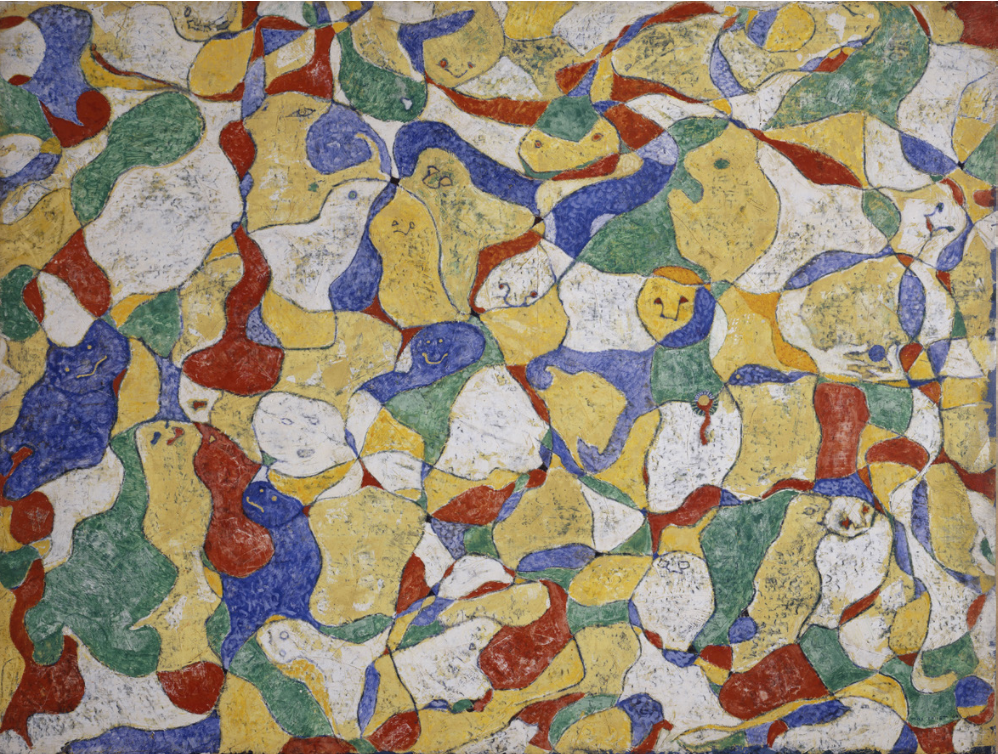MAX ERNST. Mondes magiques, mondes libérés
Max Ernst, La fête à Seillans (The Feast in Seillans), 1964
The exhibition will focus on the major themes of the worlds created by Max Ernst, by illustrating the recurrence of the themes that run through his work. A central section of the exhibition uses the four elements – water, air, earth and fire – which, according to ancient philosophical tradition and alchemy, make up all the matter in the natural world.
The artist’s oeuvre is disconcerting and remarkable. A great intellectual and humanist artist—in the neo-Renaissance sense of the term—, he continually defied perception by combining logic and formal harmony with unfathomable enigmas, while the onirism and fantastic coexist, creating landscapes with impenetrable mysteries. Forests of stones, chimeric animals, embodied masks, and anthropomorphic birds … the enigmatic and sometimes even oneiric beauty of Max Ernst’s works immerses the viewer in the extravagance of his magical and liberated world.
The exhibition will benefit from exceptional loans from the Centre Pompidou, the Tate, the Guggenheim in Venice, the Musée Cantini, the Max Ernst Museum in Brühl, and many private collectors who wish to remain anonymous.
This exhibition has been produced in collaboration with Madeinart.
CURATORSHIP
Martina Mazzotta is an art historian, author, and lecturer who studied philosophy. Brought up in the artistic environment of the publishing house Mazzotta Foundation in Milan, she studied in Germany and now lives in London, where she is a researcher associated with the Warburg Institute/UCL. She has curated many exhibitions in Italy and abroad—which have had a considerable impact on research into Kandinsky, Ciurlionis, Cage, Dubuffet, Ernst, and surrealism—, as well as contemporary art projects that have received awards. Her research focuses on the cabinets of curiosities of the late Renaissance and their legacy over the centuries. This exhibition is her second collaboration with Jürgen Pech, with whom she previously shared the curatorship of the Max Ernst retrospective in Milan (October 2022–February 2023).
Dr. Jürgen Pech has been an exhibition curator since 1984 and his specialisations are classical modernism, contemporary art, and photography. He was awarded the curatorship prize in 2019 for the exhibition and catalogue ‘Ruth Marten – Dream Lover’. Scientific Director and Head Curator of the Max Ernst Museum in Brühl from 2005 to 2021, he has been writing a catalogue raisonné of Max Ernst’s oeuvre since 2007.Selected publications: ‘Max Ernst – Portraits photographiques et documents’ (1991),’Max Ernst – Mondes graphiques’ (2003), ‘Max Ernst – Oeuvres sculpturales’ (2005), ‘Max Ernst – D-paintings. Voyage dans le temps de l’amour’ (2019), and ‘Créatures animales surréalistes’ (2021).
SCENOGRAPHY
Hubert le Gall, who is a French designer, artist, and contemporary art sculptor, has created original scenographies for many exhibitions, in particular at the Hôtel de Caumont-Art Centre: ‘Joaquín Sorolla: Spanish Master of Light’ (2020), ‘Hokusai, Utamaro, Hiroshige. the Great Masters of Japan. The Georges Leskowicz Collection’ (2019), ‘Masterpieces from the Guggenheim Foundation: From Manet to Picasso. The Thannhauser Collection’ (2019), ‘Nicolas de Staël in Provence’ (2018), and ‘Sisley the Impressionist’ (2017).
PRODUCTION AND ORGANIZATION
Emmanuelle Lussiez, Exhibitions Director, Culturespaces ; Milly Passigli, Deputy Director of Exhibition Programming ; Madeleine Balansino, Head of Exhibitions at the Hôtel de Caumont-Art Centre ; Livia Lérès et Domitille Sechet, responsible for iconography at Culturespaces.

